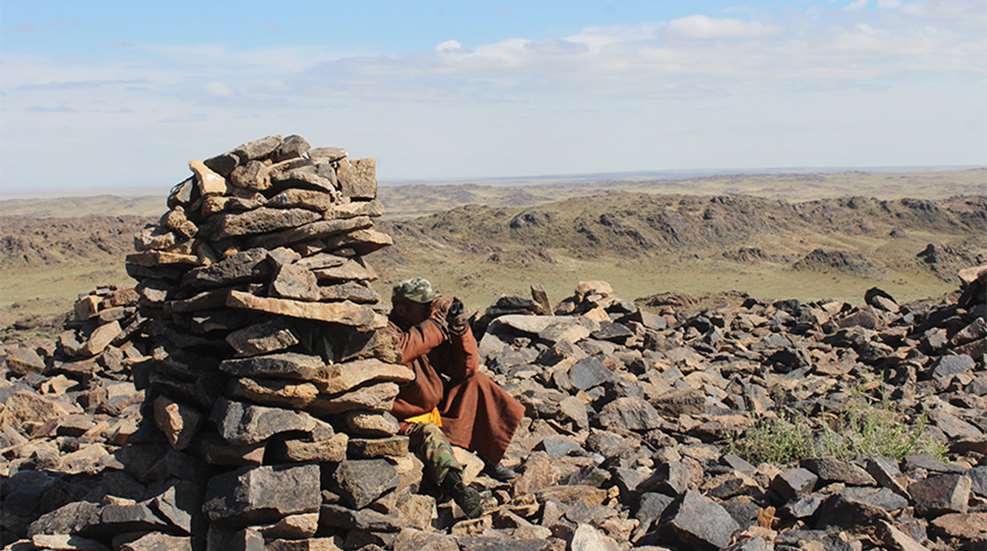
The word “desert” suggests sand and cacti. This is not the Gobi. Imagine instead a vast, treeless plain broken by rocky ridges and outcroppings in fantastic shapes. This is the Gobi. Although only the fifth-largest desert in the world, the Gobi is the largest in Asia, covering a half-million square miles of northern China and southern Mongolia. Into the 20th century it was one of the Western world’s most unknown regions, mapped primarily by Russian explorers.
Only 5 percent of the Gobi is a sand desert; much of it is capped by ancient rock interspersed with short-grass steppes. Although hardly unknown to nomadic Mongolian herdsmen from long before Genghis Khan until today, it remains an inhospitable place. Annual rainfall of just 7 inches dictates presence of grass and where—or if—the nomads may graze their flocks. The Mongolian translation of Gobi is simple and direct: “waterless place.” With elevations from 1,600 to 5,000 feet, the Gobi is “high desert,” meaning harsh winters and brutal summers. Temperatures here range from minus 40 to 120 degrees Fahrenheit, and her flat expanses often are buffeted by high winds.
Wildlife Wonder
So far this doesn’t sound like a pleasant place, but against the reality of harsh climate the Gobi is one of the most dramatically beautiful places I’ve ever seen. To the northwest lie the Altai Mountains, dramatic but not dissimilar to many mountain ranges. To the north lie the Mongolian steppes, more grass, less rocks and forested slopes. The Gobi is a unique land of endless horizons, jagged uplifts … and interesting wildlife. In its still-uncharted depths one might find wild two-humped Bactrian camels and the Mongolian wild ass; some of the rocky heights remain home to the Gobi brown bear, a small and hardy grizzly. Snow leopards, though sparse, are endemic.
Considered endangered, these “signature” Gobi species are highly protected, but the Gobi holds much more.
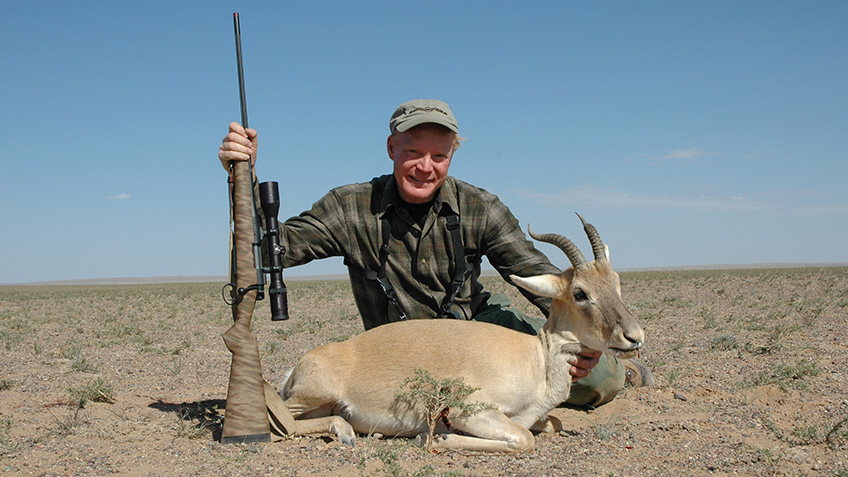
White-tailed or Mongolian gazelles roam in big herds. The smaller black-tailed gazelle prefers small family groups, but will be frequently encountered, both initially just specks on a distant plain. The Altai wapiti or maral stag, almost indistinguishable from our elk, is more a creature of the forested slopes to the north. However, after a drastic decline in the early 2000s, their numbers and range are now expanding rapidly. In September 2018, hunting along the northern edge of the Gobi, stags were bugling on every hillside and I was surprised at the number we saw.
Unlike so much of Asia, Mongolia has been continuously open to foreign sportsmen for 50 years. The game department is strong, and permit availability varies with fluctuations in wildlife populations. This roller coaster is inevitable because of Mongolia’s harsh climate; extra-severe winters and periodic drought are certain to take their toll. Rather than country-wide or by province, today Mongolian hunting permits are community-based. Depending on game surveys, communities or bands of nomads are issued permits for the areas they control.
Crown Jewels
Permit allocation today is conservative; a given community may have only two to four permits for a given species. This makes hunting in Mongolia more expensive than in years gone by … but also smooths out the ups and downs and ensures that, if a permit is issued, the game is present. Add to a 50-year history limited permits and extremely experienced local guides, and most Mongolian hunts will be successful. The gazelles are easily added to Gobi hunts, and Mongolia is a surprisingly great place to hunt elk. However, the primary reasons sportsmen and women travel to the Gobi are to hunt Gobi ibex and argali.
The Gobi ibex is essentially a subspecies of Capra sibirica, the Siberian ibex of northern Mongolia and adjacent Russia. Some authorities identify the Gobi ibex as C. s. hagenbecki. Regardless of proper scientific classification, hunters have long considered the Gobi ibex as a separate variety from the Siberian (or Altai) ibex to the northwest. For sure it is a slightly smaller ibex, generally uniformly brown with lighter underparts, and absent the pale saddle patch common to the ibex of the Altai range. The dramatically curved horns have the same thick knobs on the front edge, but due to periodic (and perennial) water shortages the horns are a bit smaller, topping out in the upper 30-inch range. Ibex are found in many of the Gobi’s rocky massifs and although density is not high, they are plentiful.
Similarly, the Gobi argali is essentially a desert adaptation of the big-bodied, long-legged, heavy-horned argali … sort of like our desert bighorn. Argalis are found in numerous subspecies from Mongolia westward to the Hindu Kush. Mongolia has two: the largest specimen in the northwest, Ovis ammon ammon, the Altai argali; and southeast of the Altais, the smaller Ovis ammon darwini. We hunters, doing our own thing and sometimes ignoring science, divide these into two: Gobi argali in Gobi proper and Hangay argali between Gobi and the Altai range. Hangay argali tend to be larger than Gobi sheep and smaller than Altai sheep but, since Gobi and Hangay argalis are both darwini, exact boundaries are a bit squishy.
Perhaps more important is that the Altai argali is generally a sheep of higher mountains, while the darwini is a creature of the Gobi’s rocky ridges and foothills. Also important is availability. Long gone are the days when one could go to Mongolia and take multiple sheep and ibex for the cost of a Texas whitetail hunt. With much more limited permits costs have escalated; the Altai argali is the most limited and, regrettably, one of the world’s costliest hunts today. However, Mongolian ibex hunts have remained relatively inexpensive.
Never forget that, in Asia, hunting sheep and hunting ibex is much the same experience. And, in places like Mongolia where the two species coexist, the two hunts are pretty much the same experience, sometimes from the same camp. There are more permits for the darwini sheep than for the big Altai argali. These hunts are not inexpensive but, today, all outfitted hunts for wild sheep are costly. Hunts for Gobi argali (and Hangay argali) are similar in cost to guided hunts for Stone sheep … or a “guaranteed permit” hunt for Rocky Mountain or desert bighorn. When we talk about “smaller” argalis, let’s keep this in perspective: These are still big sheep, with horns into the 50-inch class possible.
Ibex in Gobi
I first hunted Mongolia about 15 years ago, and again this past September, back then with Bob Kern’s Hunting Consortium and this recent time with Kaan Karakaya’s Shikar-Safaris. Differences were slight. Both times I found the Gobi dramatically beautiful, the local guides friendly and competent. I suppose that, thanks to satellite communications and the Internet, language and cultural barriers are somewhat reduced today, but both hunts were smooth and productive. After long drives into the middle of nowhere I pitched up at a neat cluster of Mongolia’s signature round felt tents, locally referred to as “gir.” (“Yurt” is a rarely uttered Russian word!) The camps are owned and maintained by (extended) families of Gobi nomads, who take good care of their visitors and are delighted with the essential revenue obtained from their permits.
Ibex hunting is what it is; all goat country starts where sheep country stops. That said, ibex hunting in the Gobi is some of the easiest in Asia because, while the rocky ridges are steep and footing is terrible, the elevation is not high and there isn’t much relief between the tops and the valleys below. The only thing that adds difficulty is the fact that in this harsh environment animal densities are low, and it can take some looking to find them. That first time in the Gobi I added the gazelles and took them out on the plains with little difficulty, but I did not hunt sheep—just couldn’t swing it.
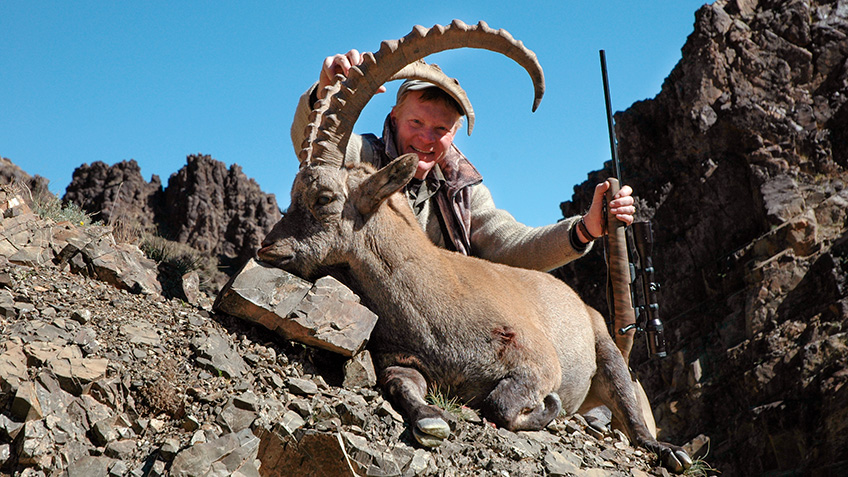
Mongolian guides are organized and know their country. With whatever manpower is available they go out like spokes of a wheel to scout and glass on horseback, motorbike, afoot or by vehicle if available. We did the same, climbing up to rocky promontories to glass. Usually we saw distant ibex, but finding a big one was another story. It took a couple of days, but somebody spotted a big billy in a steep-sided canyon. In the late morning we got the wind right and came in over a low ridge. The ibex was alone, feeding on the opposite side at about 200 yards, a really fine male, chocolate color, with long, heavy horns.
Fast-forward 15 years. It was about the same time, latter September, but the mildly chilly weather I’d enjoyed was long gone. Instead, the wind-swept Gobi was hit by gale-force winds, with some gusts exceeding 50 mph. On this hunt I didn’t add the gazelles, although we saw both varieties. But I was hunting Gobi argali in addition to ibex. In that cruel wind animals were tucked into the tightest crevices. We saw little, but my team was game. So, we fought the wind, glassing through tears in our eyes, including from the ruins of an old watch tower on a commanding knoll. The battlements are said to have dated from the days of Genghis Khan, used to light signal fires when possible enemies were seen approaching.
After a couple of hard days battling the wind, one midday, guide Jens of Shikar-Safaris and I repaired to our gir to get out of the howling wind. An hour or so later our local game guard came in, saying he’d spotted no sheep, but had found three big ibexes. We headed up a narrow canyon, and I was thinking: “In this wind, shots better be close!” He led us up over a low ridge into a boulder-strewn canyon system then stopped, motioned for stealth, and we started to crawl.
After a short hustle, eyes streaming again, he pointed toward an obvious point on the next ridge. I could see nothing … and then I saw movement across a little ledge at half the distance! I was looking too far; this ibex was barely a hundred yards, and likely all three billies were there together. I crawled forward, put my pack over a boulder and crawled in behind it with the Blaser. The ibex I’d seen was gone, around the corner into a defile, but there was another standing against dark rock, almost invisible, quartering to me. At this distance wind was not an issue. I shot him on the point of the shoulder and we found him around the corner. I don’t know if he was the largest of the three, and I also don’t know if anyone noticed that the tip of his right horn was broken. I surely did not, and it really didn’t matter; he was an ancient old warrior with heavily knobbed, deeply ringed horns. Now, if only the darned wind would lay …
Charles Darwin’s Sheep
It did, and although my time in Mongolia was growing short, we had a calm, crystal-clear morning, just below freezing with heavy frost and a light skiff of snow. We saw few sheep early; three young rams skittered over a ridge but nothing worth a second look. Toward midmorning we took a winding track that let us look across a deep canyon to the far side. Nothing … and then a dozen sheep, all ewes, came out of a hidden defile and stood. As we watched, an unseen ram came in from the right and joined them. Jens got the spotting scope on them. We were the best part of a thousand yards … the ram was heavy enough, but didn’t seem long. We’d pretty much written him off when the sheep apparently had the mutual thought and they filed away up the ridge. Walking and stopping, we stayed on the spotting scope and got several new angles. We agreed we’d been wrong at first; this was a good ram, heavy, horns well below the jaw, turning out nicely on both sides.
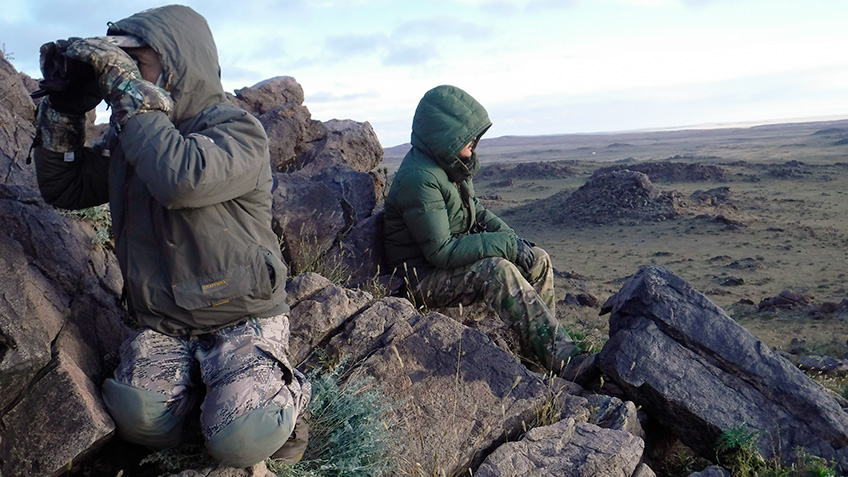
Our thinking was they’d go over the top and bed, so we split up, scouts out glassing while Jens and I made a tough climb so we could look into the pocket on the far side below where the sheep had topped out. Nothing, so we made a couple more climbs and looked into more pockets. Still nothing. Down to the bottom while the vehicle circled around and came up the valley to meet us, rendezvous for a sandwich. I was convinced we had missed them, but one of our scouts pitched up and swore he had seen the ram go over a ridge at the far end of our little range, now with just three ewes.
So, using trafficability in grassy valleys, we drove clear around the range of hills and climbed up a separate ridge, now looking back in the direction we’d come. Honestly, I was skeptical. We were the best part of 5 miles from where we’d last seen the ram: Why would he leave most of the ewes and break off with three? They had seen us, but they didn’t act that spooked. It didn’t make sense and I didn’t believe it, but the day was wearing on. I did believe he’d seen a ram, and while it couldn’t possibly be the same ram, we might as well look him over.
So, we clambered to the top of a knife-edged ridge, looking back toward the end of the major massif. We saw sheep immediately, a couple of ewes crossing a saddle. And then a ram followed. I hated to admit it, but this sure looked like the same ram: heavy, deep curls, good flare on both horns but maybe a bit better on his left. He was closer now, less than 800 yards. He hadn’t grown, but in good afternoon sunlight he looked a whole lot better. Yes, there were three ewes—and the ram—transiting a series of low, descending ridges at the end of the main ridge. They crossed one, two, three little cuts, and then, one by one, bedded on the crest of the last fold, nothing behind them but miles and miles of Gobi.
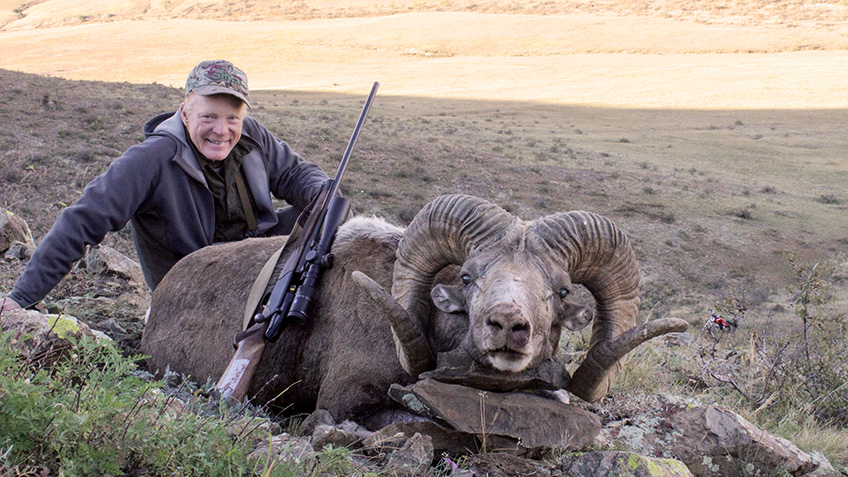
Something more than an hour of good sunlight remained, long twilight to follow. I thought we were okay. In fact, I thought we were perfect. All we had to do was descend our ridge, and hope the valley was deep enough to hide us as we crossed the low ground, then skirt along the base, climb a few hundred yards, and work our way across those little folds, one at a time.
Only rarely do things work out quite as good as they look. We’d marked several little promontories, hadn’t run into unseen sheep, and just an hour later Jens and I crawled up to the last outcropping, hardly winded. The cut between us and the last ridge was just a shallow depression. If he hadn’t moved, the ram should be just below us and to the left, not far. I crawled in first, got the backpack sited on a rock and carefully slid in behind it. Nothing … and then I saw him, slightly downhill, still bedded, facing partly away, horns still looking good. I couldn’t see the ewes at all, but I could see two-thirds of the ram’s body, just 150 yards away.
A more patient guy might have waited for the ram to get up, but this was plenty good enough. I backed off a foot and slid the Blaser over the pack. Using my hands, I plumped it up a bit to get more height, and then studied the ram through the Zeiss reticle. The shot was quartering away, the only caution to be sure I held low enough to avoid hitting too high. Accordingly, I held 3 inches below where I wanted to hit and sent a 200-grain ELD-X. No movement at all, then the ram tried to rise so I shot again. He was a beautiful darwini, and we pulled him down the slope in the last rays of Gobi sunshine.





































